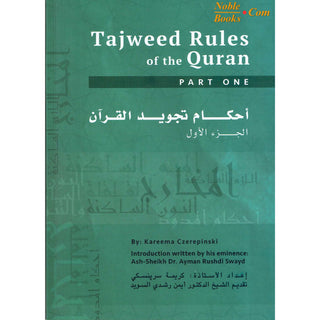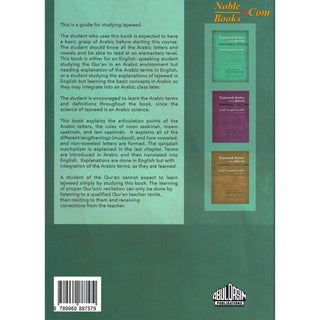Tajweed Rules of the Quran 3 Parts Set (Second Edition) By Kareema Carol Czerepinski
- Unit price
- / per
Tajweed Rules of the Quran 3 Parts Set (Second Edition) By Kareema Carol Czerepinski
- ISBN: 9789384183165
- Author: Kareema Carol Czerepinski
- Book Binding: Softcover
- Pages: 96,67,110
- Size: 8.3 x 11.7 inches
- Publication: 2019
About This Book:
Every single Muslim has to recite Qur'an in Salah but many of us do not realize that reciting the Qur'an correctly, observing the rules of recitation (tajweed) is not an advanced science for expert reciters alone, rather it is an obligation upon each and every one of us whenever we recite the Qur'an.This set of 3 renowned books on learning the Tajweed rules of the Quran will help one to understand the tajweed rules and correct their recitation with the help of a teacher. Insha-Allah. It is also great Islamic schools & Quran teachers to teach their studentsThis is a guide for studying tajweed. The student who uses this book is expected to have a basic grasp of Arabic before starting this course. The student should know all the Arabic letters and vowels and be able to read at an elementary level. This book is either for an English speaking student studying the Qur'an in an Arabic environment, but needing explanation of the Arabic terms in English, or a student studying the explanations of tajweed in English, but learning the basic concepts in Arabic so they may integrate into the Arabic terms and definitions throughout the book, since the science of tajwid is an Arabic science.
This is a complete set of 3 books.
Book 1: Tajweed Rules of the Quran Part One
This is a guide for studying tajweed. The student who uses this book is expected to have a basic grasp of Arabic before starting this course. The student should know all the Arabic letters and vowels and be able to read at an elementary level. This book is either for an English speaking student studying the Qura'an in an Arabic environment, but needing explanation of the Arabic terms in English, or a student studying the explanations of tajweed in English, but learning the basic concepts in Arabic so they may integrate into the Arabic terms and definitions throughout the book, since the science of tajweed is an Arabic science. This book explains the articulation points of the Arabic letters, the rules of noon saakinah, meem saakinah, and lam saakinah. It explains all of the different lengthenings (mudood), and how voweled, and non-voweled letters are formed. The qalaqah mechanism is explained in the last chapter. Terms are introduced in Arabic, and the translated into English. Explanations are done in English, but with integration of Arabic terms, as they are learned. A student of the Qur'an cannot except to learn tajweed simply by studying this book. The learning of proper Qur'anic recitation can only be done by listening to a qualified Qur'an teacher recite, then reciting to them and receiving corrections from the teacher.
Book 2: Tajweed Rules of the Quran Part Two
By Allah's grace, this is the second part of what shall be, insha' Allah, a three part series on the rules of tajweed of the Qur'an, for the recitation of Hafs from 'Aasim by the way of Ash-Shaaibiyyah. The book is intended to be a guide for non-Arabs with a good grasp in English in studying tajweed. This book explains the concept of the accent(an-nabr) in the recitation of the Glorious Qur'an and the conditions of its use, it also defines and explains the important chapter on the characteristics of the letters, velarization and attenuation (tafkheem and tarqeeq) are covered in the part, as well as the concept of the two alike, the two similar, the two close, and the two far and the rules for idghaam terms is made in this book to assist the student in understanding the last chapter, that of the connecting hamzah(hamzah al-wasl).
Book 3: Tajweed Rules of the Quran Part Three
This final book explains the stop and start when reading the Glorious Qur'an, and gives details as to what kind of stop is allowed, what kind preferred, and what kind of stop is forbidden. Stopping on the ends of words with strong endings (consonants)and rules for what is allowed on the last letter of the word is described, including and Stopping on the ends of words with weak endings (words ending in the alif, ya' or wow) and different rules and explanations for these type of words is clarified. One important aspect of Qur'an recitation is knowing and understanding which word combinations are written together and which separately in different parts of the Qur'an as well as in which places of the Qur'an are some words are written with the female and in which places they are written with the This part lays out the different places in the Qu'ran these occurrences take place, so the reader knows how he/she can stop on these words. The words that are read in a special way, or have two allowed ways for the reading of Hafs from 'Aasim by the way of Ash-Shaatibiyyah are detailed in this book. The history of the writing of the Glorious Qur'an and the general rules for the writing of the Qur'an are laid out in the last chapter of this part.
Adding product to your cart
You may also like
You may also like
You may also like

Recommended products
incredibly thorough. elevated. It is best to study with a teacher. May Allah reward the writer and her group.
By completing this form, you are signing up to receive our emails and can unsubscribe at any time.





